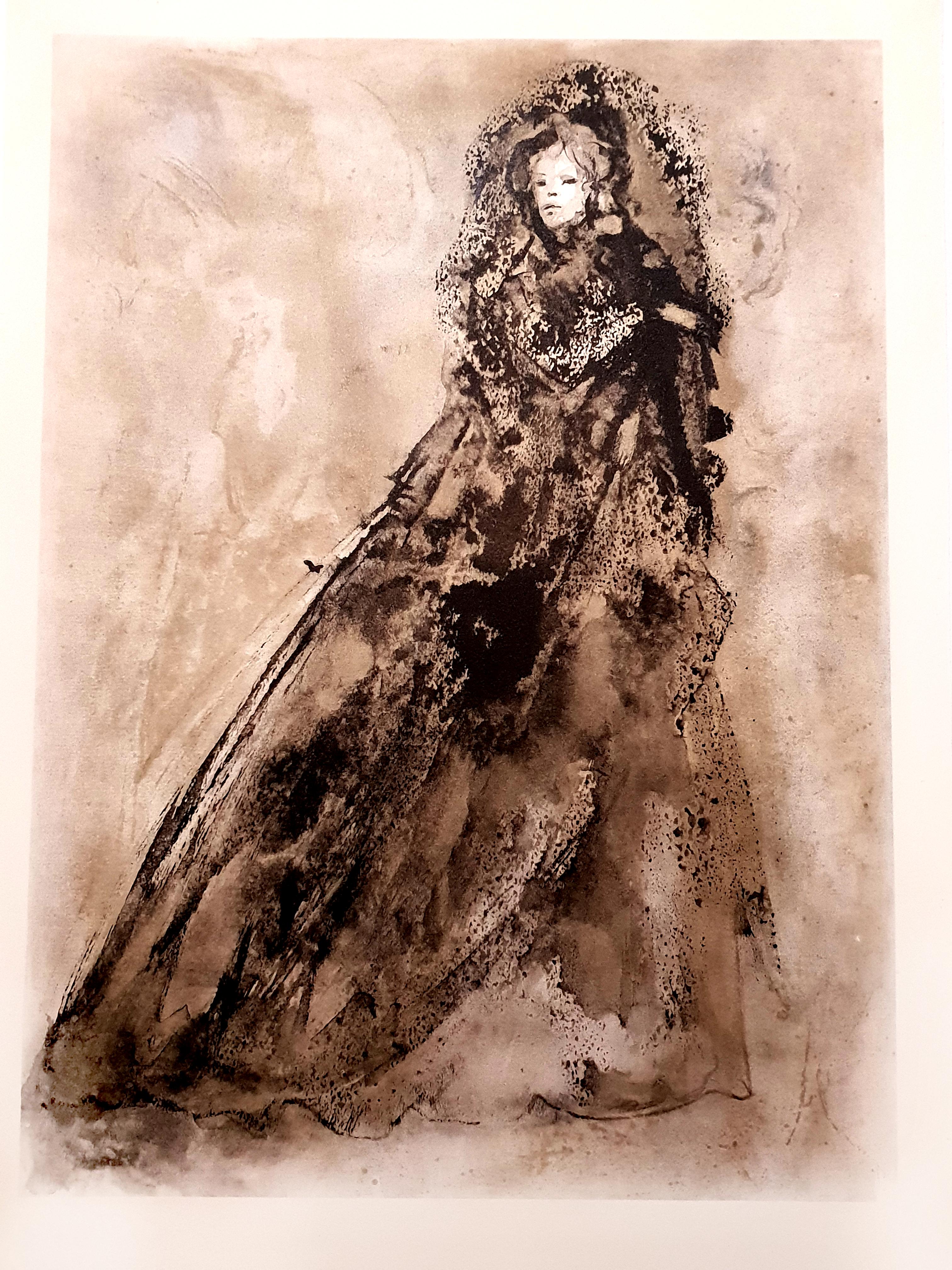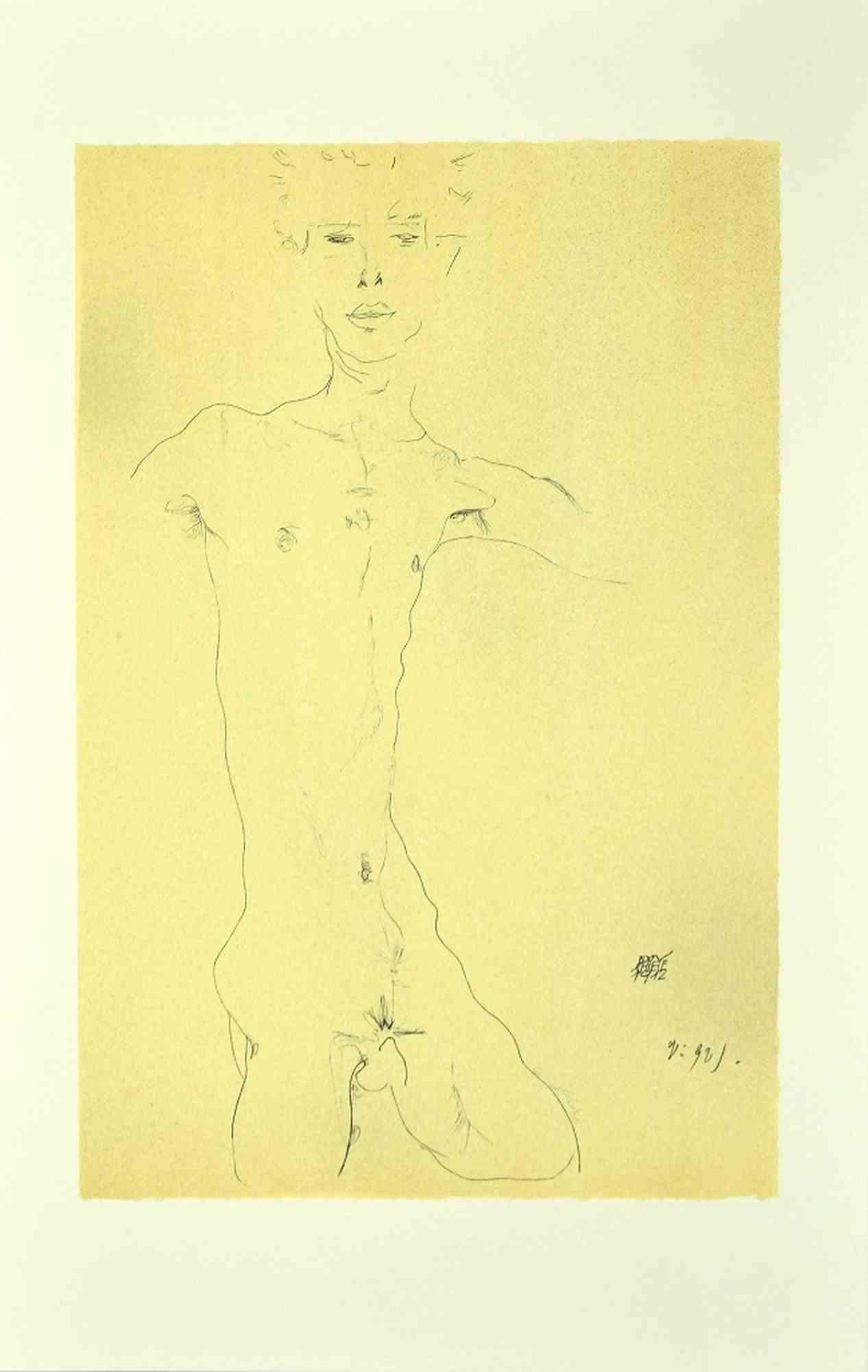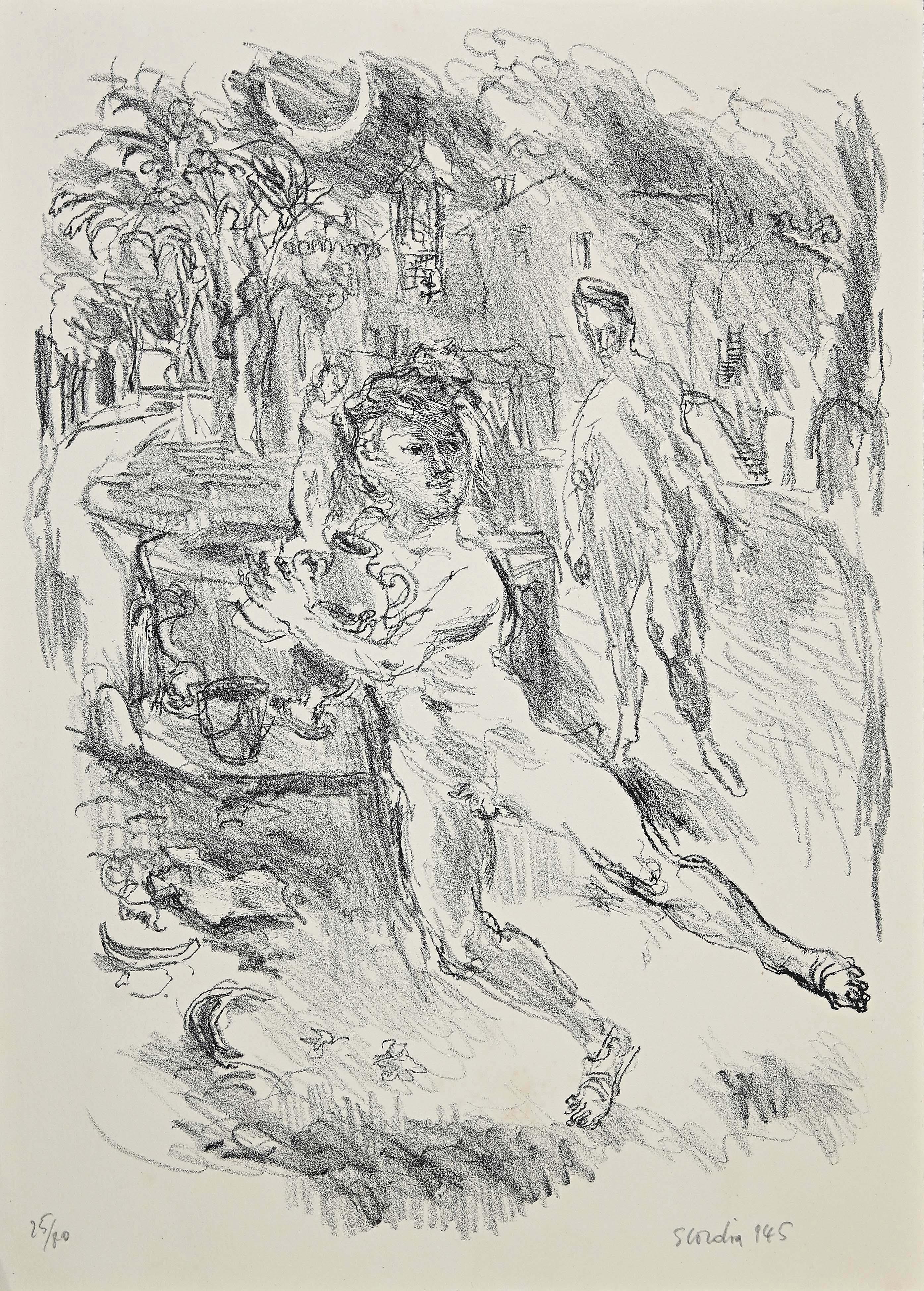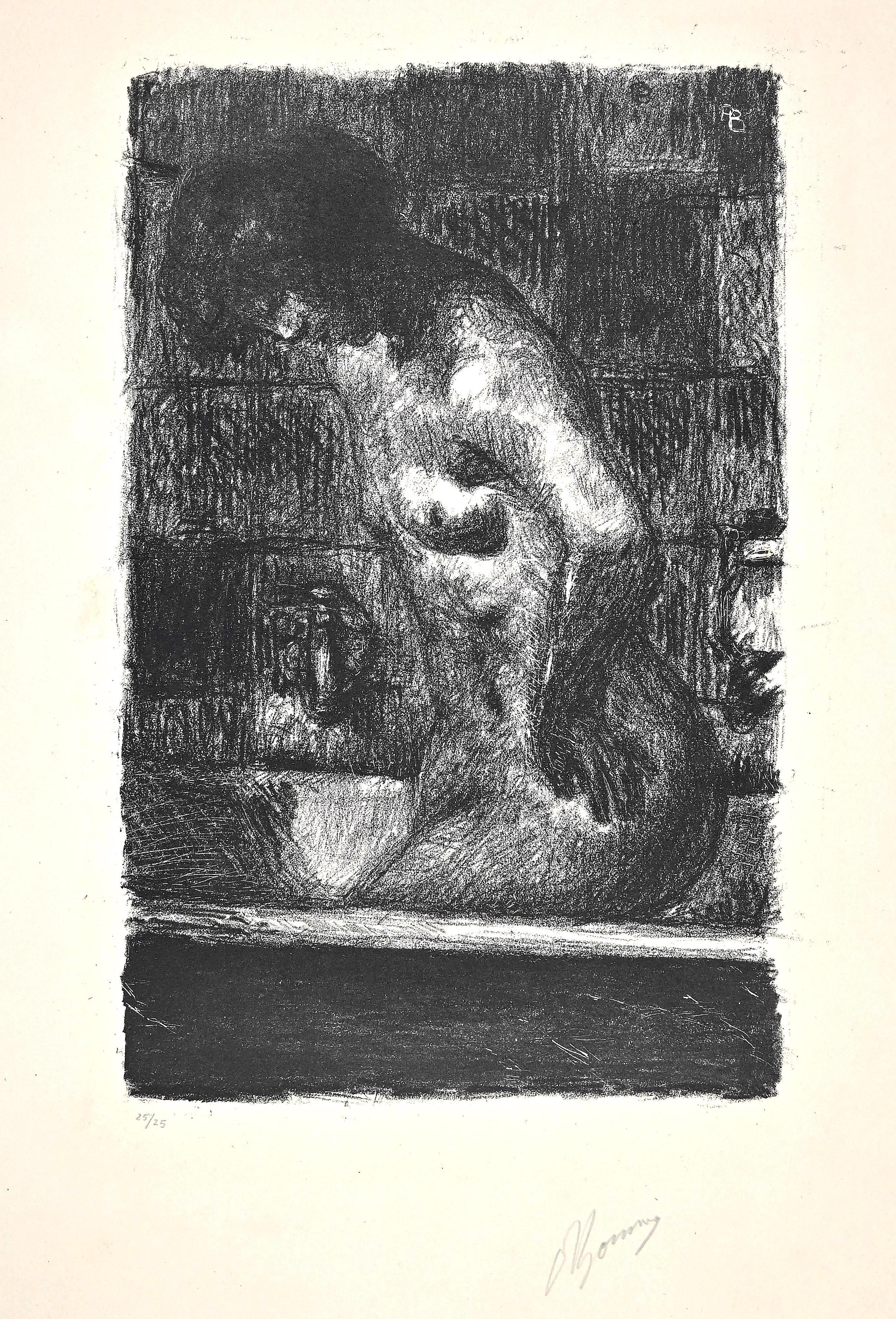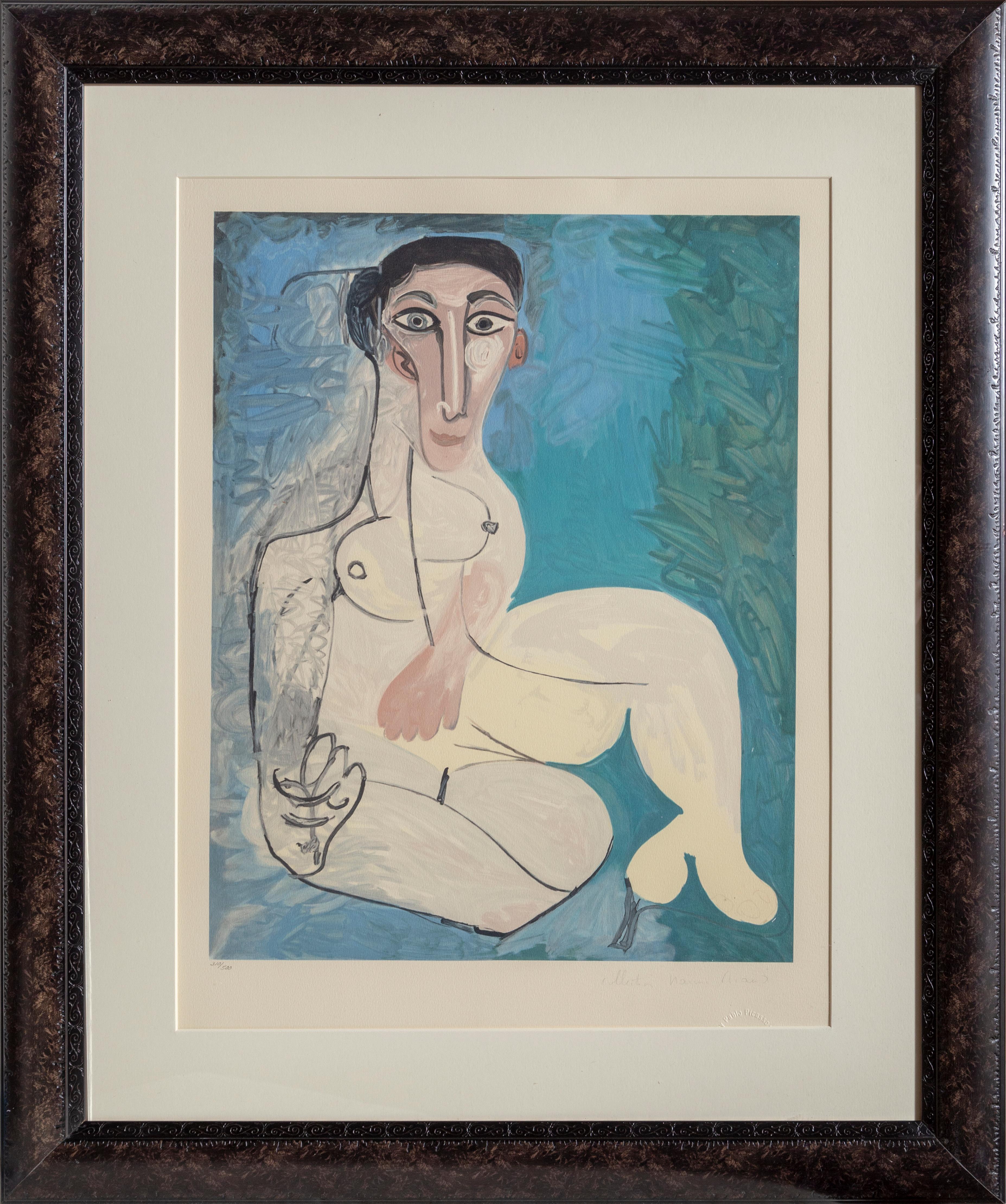Items Similar to Torso de Joven (Torso de Jeune Fille)
Want more images or videos?
Request additional images or videos from the seller
1 of 11
Rufino TamayoTorso de Joven (Torso de Jeune Fille)1969
1969
About the Item
This artwork titled "Torso de Joven (Torso de Jeune Fille)" from the suite "The Mujeres File" 1969 is an original colors lithograph on Wove paper by renown Mexican artist Rufino Tamayo, 1899-1991. It is hand signed and inscribed H.C.(Hors Commerce) in pencil by the artist. The image size is 26.85 x 21 inches, framed size is 40.75 x 33 inches. Published by Touchtone Publisher, New York, printed by Ateliers Desjobert, Paris. Referenced and pictured in the artist's catalogue raisonne by Pereda, plate #112 page 109. Custom framed in a wooden gold frame, with gold bevel and light beige matting. It is in excellent condition, it have some minor handling creases, see picture #6
About the artist:
A native of Oaxaca in Southern Mexico, Rufino Tamayo's father was a shoemaker, and his mother a seamstress. Some accounts state that he was descended from Zapotec Indians, but he was actually 'mestizo' - of mixed indigenous/European ancestry. (Santa Barbara Museum of Art). He began painting at age 11. Orphaned at the age of 12, Tamayo moved to Mexico City, where he was raised by his maternal aunt who owned a wholesale fruit business.
In 1917, he entered the San Carlos Academy of Fine Arts, but left soon after to pursue independent study. Four years later, Tamayo was appointed the head designer of the department of ethnographic drawings at the National Museum of Archaeology in Mexico City. There he was surrounded by pre-Colombian objects, an aesthetic inspiration that would play a pivotal role in his life. In his own work, Tamayo integrated the forms and tones of pre-Columbian ceramics into his early still lives and portraits of Mexican men and women.
In the early 1920s he also taught art classes in Mexico City's public schools. Despite his involvement in Mexican history, he did not subscribe to the idea of art as nationalistic propaganda. Modern Mexican art at that time was dominated by 'The Three Great Ones' : Diego Rivera, Jose Clemente Orozco, and David Alfaro Siqueros, but Tamayo began to be noted as someone 'new' and different' for his blending of the aesthetics of post Revolutionary Mexico with the vanguard artists of Europe and the United States.
After the Mexican Revolution, he focused on creating his own identity in his work, expressing what he thought was the traditional Mexico, and refusing to follow the political trends of his contemporary artists. This caused some to see him as a 'traitor' to the political cause, and he felt it difficult to freely express himself in his art. As a result, he decided to leave Mexico in 1926 and move to New York, along with his friend, the composer Carlos Chavez. The first exhibition of Tamayo's work in the United States was held at the Weyhe Gallery, New York, in that same year. The show was successful, and Tamayo was praised for his 'authentic' status as a Mexican of 'indigenous heritage', and for his internationally appealing Modernist aesthetic. (Santa Barbara Museum of Art).
Throughout the late thirties and early forties New York's Valentine Gallery gave him shows. For nine years, beginning in 1938, he taught at the Dalton School in New York.
In 1929, some health problems led him to return to Mexico for treatment. While there he took a series of teaching jobs. During this period he became romantically involved with the artist Maria Izquierdo, with whom he lived and worked for several years. In 1933 he completed his first successful mural commission, a series of wall paintings for the Escuela Nacional de Musica (National School of Music). While working on this project, he met Olga Flores Rivas, a piano student at the school. Soon he separated from Izquierdo, and began a romance with Olga. The two were married in 1934. Although Olga was talented and had a budding performance career, she abandoned her musical pursuits to devote herself to promoting Tamayo's work. She was a lifelong muse to the artist, and over his seventy year career, he drew and painted many portraits of her.
They moved to New York in 1937, and he began to exhibit his work internationally. From 1937 to 1949, Tamayo and Olga lived there, and he became widely recognized for his signature form of abstract figuration. Some of his most valuable works were created during that time.
In 1943 Tamayo painted his first mural in the United States at the Hillyer Art Library at Smith College. Vogue magazine's 1946 issue referred to him as 'the best of young painters'. Look magazine also named him 'a fixed star in the New York art world'. (Santa Barbara Museum of Art) He was an elegant and media-savvy man, often photographed in his Upper East Side studio, with its wall of windows facing out onto Manhattan's fashionable townhouses.
The 1940s were however not without problems for the couple. Olga suffered from health problems, leading to several miscarriages, and the marriage was strained. Tamayo dedicated his work to her by adding an extra 'O' to his signature.
His fame was growing in Mexico. In 1948 his first major retrospective was held at the Palacio de Bellas Artes in Mexico City, and while he was still controversial, his popularity was high. He enjoyed broad commercial and critical success, but remained uncomfortable with the political differences and controversy, and so Tamayo and Olga moved to Paris in 1949. There he was welcomed by the artists and intellectuals of Europe. The French government named him Chevalier and Officier de la Légion d'Honneur in 1956 and 1969, respectively, and he was the recipient of numerous other honors and awards. Tamayo was among the first Mexican artists to be included in the Venice Biennale. He remained in Paris for 10 years, after which the couple returned permanently to Mexico.
His work was exhibited internationally in group and solo shows. Important Tamayo retrospectives took place at the São Paulo Bienal in 1977 and the Solomon R. Guggenheim Museum, New York, in 1979.
From 1933 to 1980, Tamayo painted 21 murals for an array of universities, libraries, museums, civic and corporate clients, hotels and an ocean liner. He was also an influential printmaker, and, in the latter part of his life embarked on the creation of sculpture. Tamayo eschewed the highly politicized themes explored within the works of his peers, and favored lyrical imagery and incorporated elements of Cubism, Surrealism and Expressionism. Mexican folklore and his Indian origins provided a constant source of inspiration for him.
Through his 70s and 80s he continued to be a prolific artist, teacher, and collector. Critics have extolled his bold and saturated use of color as his most significant contribution to Modern art. He was elected an honorary member of the American Academy and National Institute of Arts and Letters in 1961.
Rufino and Olga Tamayo donated the Museum of Pre-Hispanic Mexican Art to their native State of Oaxaca in 1974. Their personal holdings of more than 1,000 pieces of ceramics and sculpture formed the cornerstone of the collection. The Rufino Tamayo Museum of International Contemporary Art opened in Mexico in 1981, and it displays many of the artist's works, as well as paintings, sculpture and drawings from his private collection. At the time, it was the first major museum not run by the Government.
Tamayo painted his last painting in 1989, at the age of 90, 'Hombre Con Flor' (Man withFlower), a self-portrait. Rufino Tamayo died in 1991 at the age of 92 in Mexico City. Olga passed away two and a half years later.
The work of Rufino Tamayo is held in major collections and numerous museums worldwide.
- Creator:Rufino Tamayo (1899-1991, Mexican)
- Creation Year:1969
- Dimensions:Height: 40.75 in (103.51 cm)Width: 33 in (83.82 cm)Depth: 1.25 in (3.18 cm)
- Medium:
- Movement & Style:
- Period:
- Condition:
- Gallery Location:San Francisco, CA
- Reference Number:
Rufino Tamayo
Rufino Tamayo was born in Oaxaca, Mexico, in 1899 to parents Manuel Arellanes and Florentina Tamayo. Tamayo was active in the mid-20th century in Mexico and New York, painting figurative abstraction with surrealist influences. Although Tamayo studied drawing at the Academy of Art at San Carlos as a young adult, he became dissatisfied and eventually decided to study on his own.
About the Seller
5.0
Platinum Seller
These expertly vetted sellers are 1stDibs' most experienced sellers and are rated highest by our customers.
Established in 1999
1stDibs seller since 2017
688 sales on 1stDibs
Typical response time: 1 hour
- ShippingRetrieving quote...Ships From: San Francisco, CA
- Return PolicyA return for this item may be initiated within 7 days of delivery.
More From This SellerView All
- Torso de MujerBy Rufino TamayoLocated in San Francisco, CAThis artwork titled "Torso de Mujer (Torso de Femmee)" from the suite "The Mujeres File" 1969 is an original colors lithograph on Wove paper by renown Mexican artist Rufino Tamayo, 1899-1991. It is hand signed and inscribed H.C. (Hors Commerce) in pencil by the artist. The image size is 26.85 x 21 inches, framed size is 40.75 x 33 inches. Published by Touchtone Publisher, New York, printed by Ateliers Desjobert, Paris. Referenced and pictured in the artist's catalogue raisonne by Pereda, plate #108 page 107. Custom framed in a wooden gold frame, with gold bevel and light beige fabric matting. It is in excellent condition. About the artist: A native of Oaxaca in Southern Mexico, Rufino Tamayo's father was a shoemaker, and his mother a seamstress. Some accounts state that he was descended from Zapotec Indians, but he was actually 'mestizo' - of mixed indigenous/European ancestry. (Santa Barbara Museum of Art). He began painting at age 11. Orphaned at the age of 12, Tamayo moved to Mexico City, where he was raised by his maternal aunt who owned a wholesale fruit business. In 1917, he entered the San Carlos Academy of Fine Arts, but left soon after to pursue independent study. Four years later, Tamayo was appointed the head designer of the department of ethnographic drawings at the National Museum of Archaeology in Mexico City. There he was surrounded by pre-Colombian objects, an aesthetic inspiration that would play a pivotal role in his life. In his own work, Tamayo integrated the forms and tones of pre-Columbian ceramics...Category
Mid-20th Century Modern Figurative Prints
MaterialsLithograph
- La Negra (The Black Woman)By Rufino TamayoLocated in San Francisco, CAThis artwork titled "La Negra (The Black Woman)" from the suite "The Mujeres File" 1969 is an original colors lithograph on B.F.K. Rives paper by renown Mexican artist Rufino Tamayo, 1899-1991. It is hand signed and numbered 150/150 in pencil by the artist. The image size is 26.85 x 21.25 inches, sheet size is 29.5 x 22.15 inches, framed size is 42 x 35 inches. Published by Touchtone Publisher, New York, printed by Ateliers Desjobert, Paris. Referenced and pictured in the artist's catalogue raisonne by Pereda, plate #109 page 107. Custom framed in a wooden silver frame, with silver spacer and fabric matting. It is in excellent condition. About the artist: A native of Oaxaca in Southern Mexico, Rufino Tamayo's father was a shoemaker, and his mother a seamstress. Some accounts state that he was descended from Zapotec Indians, but he was actually 'mestizo' - of mixed indigenous/European ancestry. (Santa Barbara Museum of Art). He began painting at age 11. Orphaned at the age of 12, Tamayo moved to Mexico City, where he was raised by his maternal aunt who owned a wholesale fruit business. In 1917, he entered the San Carlos Academy of Fine Arts, but left soon after to pursue independent study. Four years later, Tamayo was appointed the head designer of the department of ethnographic drawings at the National Museum of Archaeology in Mexico City. There he was surrounded by pre-Colombian objects, an aesthetic inspiration that would play a pivotal role in his life. In his own work, Tamayo integrated the forms and tones of pre-Columbian ceramics into his early still lives and portraits of Mexican men and women. In the early 1920s he also taught art classes in Mexico City's public schools. Despite his involvement in Mexican history, he did not subscribe to the idea of art as nationalistic propaganda. Modern Mexican art at that time was dominated by 'The Three Great Ones' : Diego Rivera, Jose Clemente Orozco, and David Alfaro Siqueros, but Tamayo began to be noted as someone 'new' and different' for his blending of the aesthetics of post Revolutionary Mexico with the vanguard artists of Europe and the United States. After the Mexican Revolution, he focused on creating his own identity in his work, expressing what he thought was the traditional Mexico, and refusing to follow the political trends of his contemporary artists. This caused some to see him as a 'traitor' to the political cause, and he felt it difficult to freely express himself in his art. As a result, he decided to leave Mexico in 1926 and move to New York, along with his friend, the composer Carlos Chavez. The first exhibition of Tamayo's work in the United States was held at the Weyhe Gallery, New York, in that same year. The show was successful, and Tamayo was praised for his 'authentic' status as a Mexican of 'indigenous heritage', and for his internationally appealing Modernist aesthetic. (Santa Barbara Museum of Art). Throughout the late thirties and early forties New York's Valentine Gallery gave him shows. For nine years, beginning in 1938, he taught at the Dalton School in New York. In 1929, some health problems led him to return to Mexico for treatment. While there he took a series of teaching jobs. During this period he became romantically involved with the artist Maria Izquierdo...Category
Mid-20th Century Modern Figurative Prints
MaterialsLithograph
- Une Jeune Femme Presente Avec Grace, from Les Enfants TrouvesBy (after) René MagritteLocated in San Francisco, CAThis artwork titled "" Une Jeune Femme Presente Avec Grace" from the suite" Les Enfants Trouves created in 1953 and printed/published in 1968 in an...Category
Mid-20th Century Surrealist Nude Prints
MaterialsLithograph
- UntitledBy Théophile Alexandre SteinlenLocated in San Francisco, CAArtist: Theophile Alexandre Steinlen (Swiss, 1859-1923) Title: Untitled Year: c.1915 Medium: Lithograph Edition: Unknown, probably 400 Paper: Thin vellum Image size: 1...Category
Early 20th Century Realist Figurative Prints
MaterialsLithograph
- Three Native American GirlsBy Popo and Ruby LeeLocated in San Francisco, CAThis artwork "Three Native American Girls" c. 1990 is a color offset lithograph by noted artists Popo and Ruby Lee, b.1940. It is Hand signed and numbered 2/750 in pencil by the arti...Category
Late 20th Century American Realist Nude Prints
MaterialsLithograph
- Two Native American GirlsBy Popo and Ruby LeeLocated in San Francisco, CAThis artwork "two Native American Girls" c. 1990 is a color offset lithograph by noted artists Popo and Ruby Lee, b.1940. It is Hand signed and numbered 501/750 in pencil by the arti...Category
Late 20th Century American Realist Nude Prints
MaterialsLithograph
You May Also Like
- Leonor Fini - Original LithographBy Leonor FiniLocated in Collonge Bellerive, Geneve, CHLeonor Fini - Original Lithograph The Flowers of Evil 1964 Conditions: excellent Edition: 500 Dimensions: 46 x 34 cm Editions: Le Cercle du Livre Précieux, Paris Unsigned and unumb...Category
1960s Modern Nude Prints
MaterialsLithograph
- Standing Male Nude - Lithograph - 2007By Egon SchieleLocated in Roma, ITStanding Male Nude is a beautiful colored lithograph from the portfolio " Erotica " after Egon Schiele. It deals with a reproduction of the homonym artwork realized in pencil by Eg...Category
Early 2000s Modern Figurative Prints
MaterialsLithograph
- The Escape - Lithograph by Antonio Scordia - 1945By Antonio ScordiaLocated in Roma, ITThe Escape is an original lithograph artwork realized by Antonio Scordia in 1945. Edition of 25/80 prints. Hand-signed in pencil on the lower right; numbered on the lower left. Good conditions. The artwork represents two figures, in the front the nude one, resembles the Hermes, with his position of flying and his feet. The artwork is created through quick and confident strokes, in a well-balanced composition. Antonio Scordia (Santa Fè, Argentina, 1918 - Rome, 1988) was an Italian painter. In 1921, he moved to Rome with his family where he attended the School of the Academy of France...Category
1940s Modern Figurative Prints
MaterialsLithograph
- Nude - Lithograph by Pericle Fazzini - 1958Located in Roma, ITNude is a fine lithograph on paper, realized by the Italian artist Pericle Fazzini in 1958. The print depicts a female nude posing. Hand signed and d...Category
1950s Modern Figurative Prints
MaterialsLithograph
- Femme Debout dans sa Baignoire - Lithograph by Pierre Bonnard - 1920sBy Pierre BonnardLocated in Roma, ITVery rare edition of only 25 prints on vélin fort, numbered and signed by the artist. Redness on left side of the sheet, otherwise excellent conditions and in full margins. Dry stamp...Category
1920s Modern Nude Prints
MaterialsLithograph
- Femme Nue Assise dans l’Herbe, Cubist Lithograph by Pablo PicassoBy Pablo PicassoLocated in Long Island City, NYA lithograph from the Marina Picasso Estate Collection after the Pablo Picasso painting "Femme Nue Assise dans l'Herbe". The original painting was completed in 1961. In the 1970's a...Category
1980s Modern Figurative Prints
MaterialsLithograph
Recently Viewed
View AllMore Ways To Browse
Torso Vintage
Torso Figure
Ocean Liner Art
Gold Torso
Vintage Olga
Cubism Still Life 20th Century
De Rivera
Framed Fruit Prints
80s Lithograph
1920s French Lithograph Framed
American Indian Figurative Prints
Man Torso
Art The Seamstress
Pre Columbian Mexican Art
Abstract Fruit Print
Musical Wall Sculpture
Hand Painted Women Plates
Native Indian Lithograph
